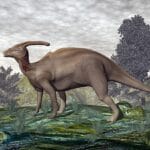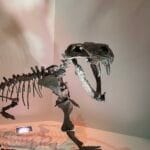A Jurassic Giant Emerges
Buckle up for a journey back to the Late Jurassic period, roughly 150 million years ago. North America, teeming with prehistoric life, was home to a diverse array of creatures, from lumbering herbivores to agile predators. Among them, a formidable hunter stalked the land: Allosaurus, the “different lizard.”
This apex predator, with its awe-inspiring size and bone-crushing bite, has captivated paleontologists and dinosaur enthusiasts for over a century. But how much do we really know about this Jurassic giant? Join us as we delve into the latest discoveries, unravel the mysteries surrounding Allosaurus, and explore its reign as one of the most formidable carnivores to ever walk the Earth.
A Closer Look at the “Different Lizard”
Allosaurus earns its name from the unique structure of its vertebrae, which were concave and differed from those of other dinosaurs known at the time of its discovery. This distinctive feature, along with its massive skull, powerful legs, and sharp claws, makes Allosaurus a standout figure in the fossil record.
Size and Anatomy: A Formidable Predator
Imagine an animal as long as a school bus – that’s roughly 28 feet of predatory power! Allosaurus could grow to be one of the largest carnivores of its time, with some estimates suggesting individuals may have reached lengths of up to 39 feet! Weighing in at an estimated 1.7 to 3.6 metric tons, roughly the weight of two cars, Allosaurus was a force to be reckoned with.
But this dinosaur was more than just brute strength. Its skull, armed with rows of serrated teeth, was designed for tearing through flesh. Its short, powerful arms, tipped with sharp claws, likely helped pin struggling prey. And its long, muscular tail provided balance and agility, making Allosaurus a surprisingly agile hunter for its size.
Allosaurus vs. Stegosaurus: A Jurassic Showdown
One cannot discuss Allosaurus without mentioning its legendary battles with another Jurassic icon: Stegosaurus. This heavily armored herbivore, with its iconic plates and spiked tail, likely presented a formidable challenge.
Evidence suggests that these two titans clashed frequently. Fossilized bones reveal bite marks from Allosaurus on Stegosaurus plates, as well as puncture wounds on Allosaurus bones that match the size and shape of Stegosaurus tail spikes. These prehistoric battles, though likely brutal, were a testament to the power of evolution, showcasing the remarkable adaptations that both predator and prey developed to survive.
Unearthing a Legacy: The Story of Allosaurus Discovery
The tale of Allosaurus discovery is intertwined with one of the most fascinating periods in paleontological history: the “Bone Wars.” This fierce rivalry between paleontologists Othniel Charles Marsh and Edward Drinker Cope, fueled by ambition and a thirst for recognition, ultimately led to the discovery of numerous dinosaur species, including Allosaurus.
A History Mired in Competition
The first Allosaurus fossil was unearthed in 1877 by Othniel Charles Marsh. However, the intense competition between Marsh and his rival, Edward Drinker Cope, resulted in a rush to name new species, often based on incomplete or fragmentary remains. This led to a great deal of confusion in the early days of Allosaurus research, with multiple names assigned to what are now believed to be the same species.
From Scattered Bones to a Global Icon
Despite the early confusion surrounding its classification, Allosaurus has become one of the most well-studied dinosaurs, thanks in part to the abundance of fossils discovered in the Morrison Formation of Western North America. These fossils, ranging from isolated bones to nearly complete skeletons, have provided paleontologists with a wealth of information about its anatomy, growth, and behavior.
Today, Allosaurus continues to captivate audiences worldwide, holding a prominent position in museum exhibits, documentaries, and popular culture.
Unanswered Questions: The Ongoing Allosaurus Investigation
While we have learned a great deal about Allosaurus, many questions remain. Ongoing research and new fossil discoveries promise to shed light on some of the more intriguing aspects of this dinosaur’s life.
Social Structures and Hunting Strategies
One of the most enduring mysteries surrounding Allosaurus is whether it hunted alone or in packs. While some evidence, such as fossilized trackways, suggests that Allosaurus may have moved in groups, the exact nature of these groups and their hunting strategies remain unclear.
Did Allosaurus coordinate attacks like modern-day wolves, or did they engage in more opportunistic group feeding? Further research, including analysis of bone chemistry, muscle attachments, and brain structure, may provide clues to unravel this mystery.
Growth Rates and Life History
Another area of ongoing research focuses on Allosaurus‘s rapid growth rates. Studies suggest that these dinosaurs reached near-adult size by the age of 15, giving them a significant advantage over rivals and potentially influencing their social interactions.
How did this rapid growth affect Allosaurus‘s life history, and what implications did it have for the Jurassic ecosystem? Future research promises to delve deeper into these questions, piecing together the puzzle of Allosaurus‘s remarkable life.
Allosaurus: A Lasting Legacy
Allosaurus, with its impressive size, formidable hunting adaptations, and air of mystery, continues to inspire awe and wonder. This “different lizard,” a product of millions of years of evolution, offers a unique window into the past, reminding us of the incredible diversity of life that once existed on our planet. As paleontologists continue to unearth new fossils and employ cutting-edge technology to analyze existing evidence, we can look forward to an even more complete and nuanced understanding of Allosaurus, its behavior, and its role in the grand tapestry of prehistoric life.
- SYBAU See You Baby Meaning: Gen Z Slang Evolves - July 1, 2025
- Unlock Your Inner Youth: Lifestyle Secrets for a Vibrant Life - July 1, 2025
- Decode SYBAU Meaning: Gen Z Slang Explained - July 1, 2025






